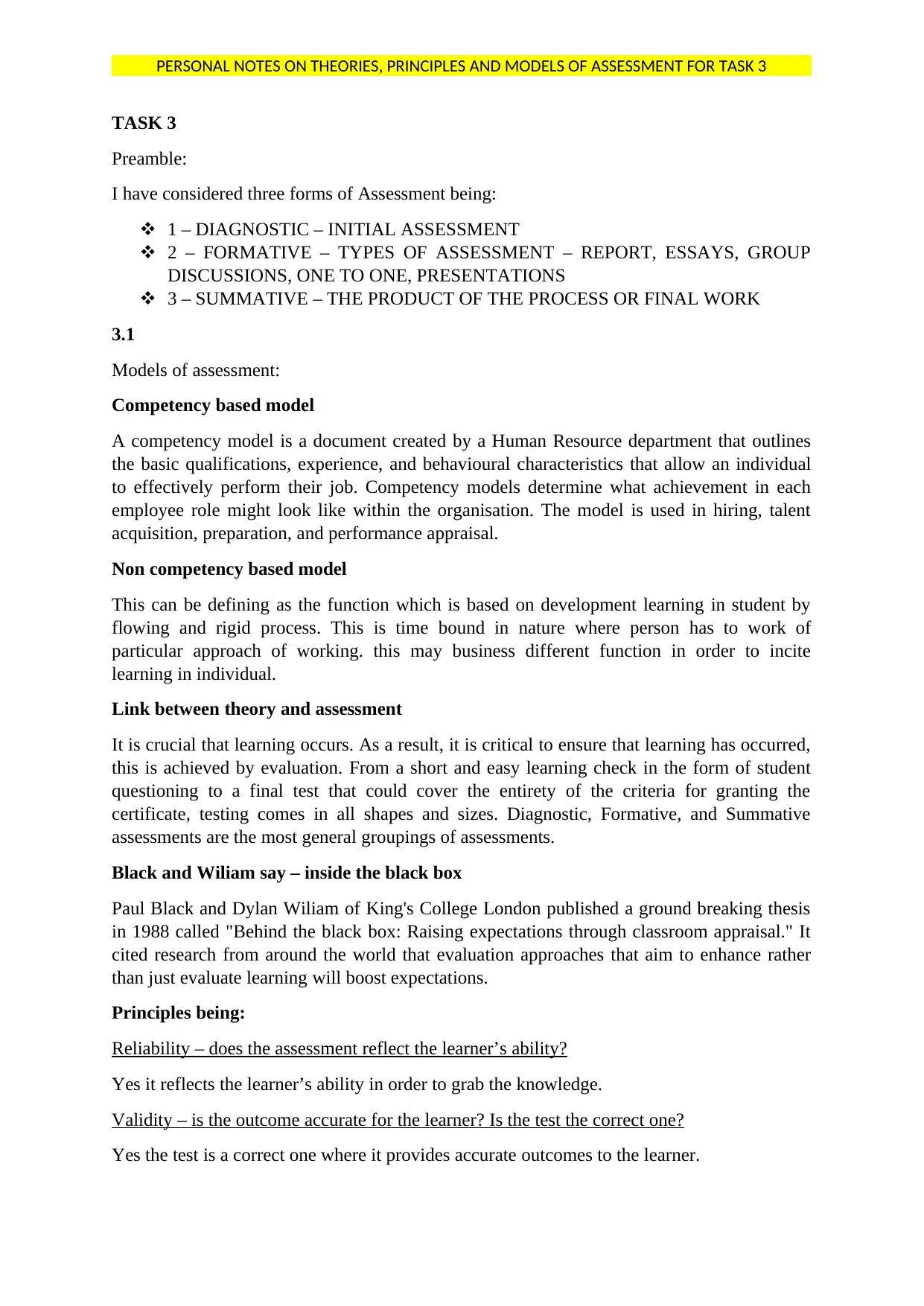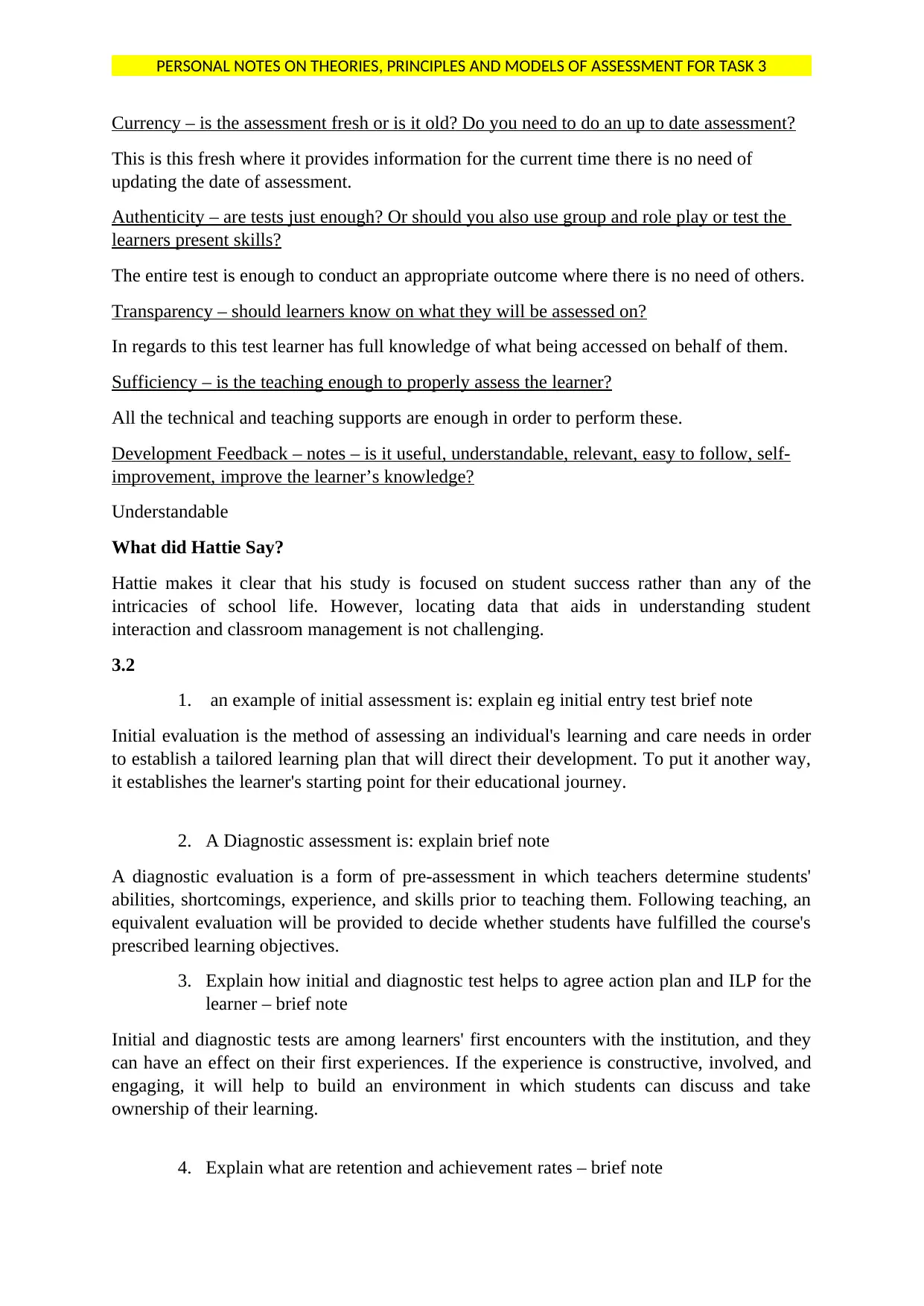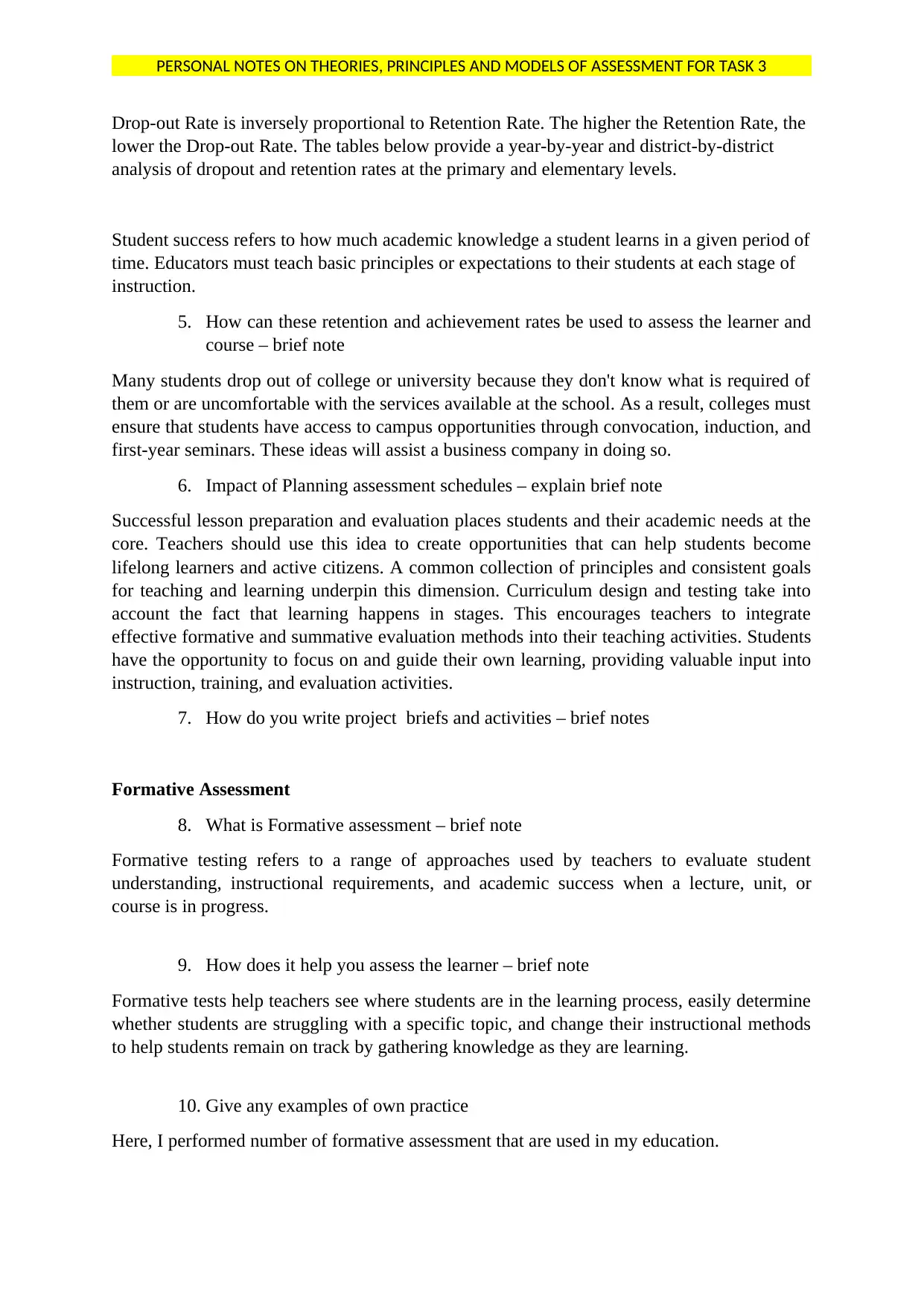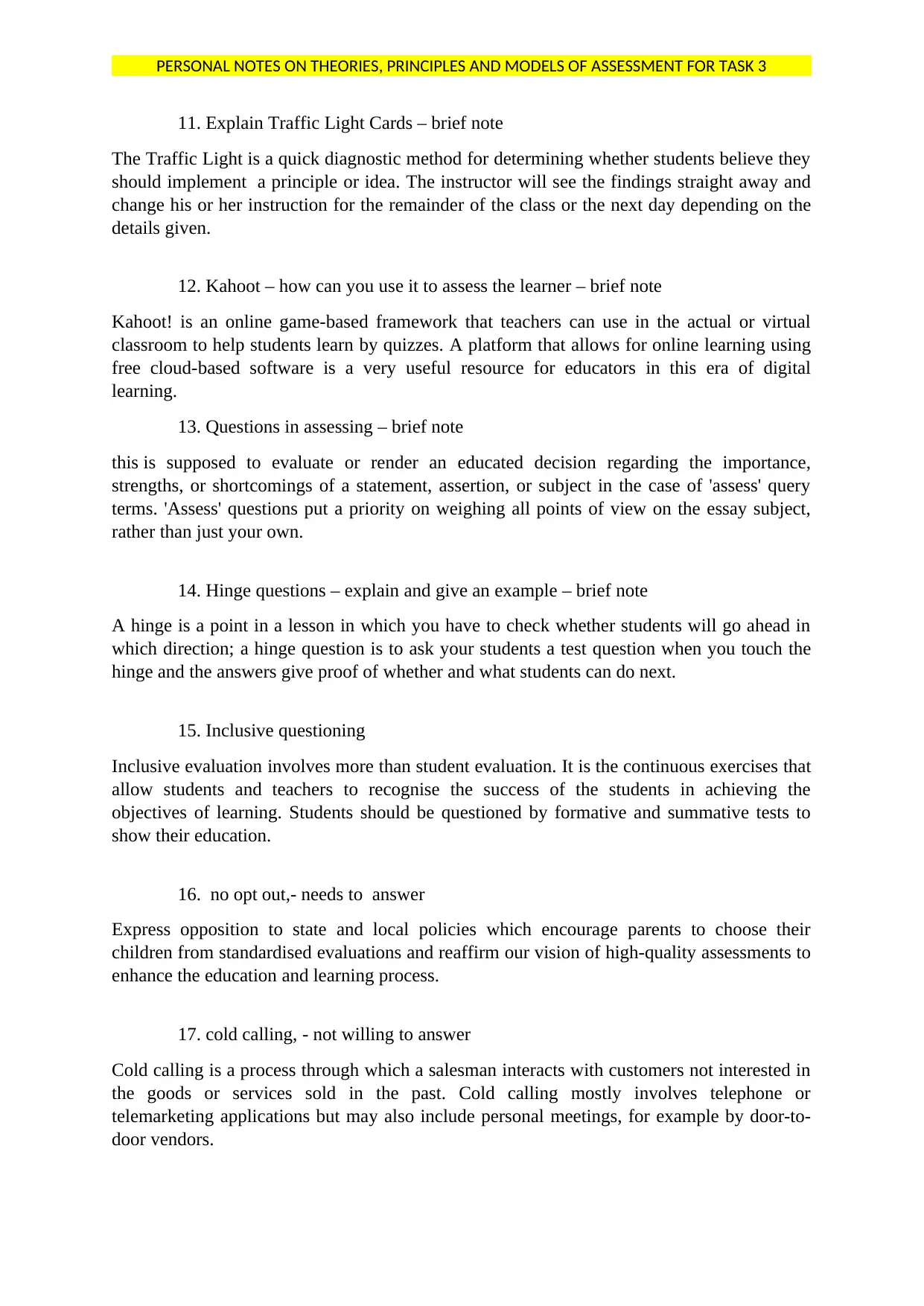Personal Notes on Assessment Theories, Principles and Models - Task 3
VerifiedAdded on 2022/12/27
|4
|1681
|2
Homework Assignment
AI Summary
This assignment provides a comprehensive overview of assessment theories, principles, and models, focusing on diagnostic, formative, and summative assessments. It explores competency-based and non-competency-based models, emphasizing the link between theory and assessment. The document delves into key principles like reliability, validity, and authenticity. It includes examples of initial and diagnostic assessments, explains retention and achievement rates, and discusses the impact of planning assessment schedules. Furthermore, it covers formative assessment techniques such as traffic light cards, Kahoot!, and inclusive questioning, providing practical insights and examples. The assignment also references key concepts from educational research, offering a well-rounded understanding of assessment practices.

PERSONAL NOTES ON THEORIES, PRINCIPLES AND MODELS OF ASSESSMENT FOR TASK 3
TASK 3
Preamble:
I have considered three forms of Assessment being:
1 – DIAGNOSTIC – INITIAL ASSESSMENT
2 – FORMATIVE – TYPES OF ASSESSMENT – REPORT, ESSAYS, GROUP
DISCUSSIONS, ONE TO ONE, PRESENTATIONS
3 – SUMMATIVE – THE PRODUCT OF THE PROCESS OR FINAL WORK
3.1
Models of assessment:
Competency based model
A competency model is a document created by a Human Resource department that outlines
the basic qualifications, experience, and behavioural characteristics that allow an individual
to effectively perform their job. Competency models determine what achievement in each
employee role might look like within the organisation. The model is used in hiring, talent
acquisition, preparation, and performance appraisal.
Non competency based model
This can be defining as the function which is based on development learning in student by
flowing and rigid process. This is time bound in nature where person has to work of
particular approach of working. this may business different function in order to incite
learning in individual.
Link between theory and assessment
It is crucial that learning occurs. As a result, it is critical to ensure that learning has occurred,
this is achieved by evaluation. From a short and easy learning check in the form of student
questioning to a final test that could cover the entirety of the criteria for granting the
certificate, testing comes in all shapes and sizes. Diagnostic, Formative, and Summative
assessments are the most general groupings of assessments.
Black and Wiliam say – inside the black box
Paul Black and Dylan Wiliam of King's College London published a ground breaking thesis
in 1988 called "Behind the black box: Raising expectations through classroom appraisal." It
cited research from around the world that evaluation approaches that aim to enhance rather
than just evaluate learning will boost expectations.
Principles being:
Reliability – does the assessment reflect the learner’s ability?
Yes it reflects the learner’s ability in order to grab the knowledge.
Validity – is the outcome accurate for the learner? Is the test the correct one?
Yes the test is a correct one where it provides accurate outcomes to the learner.
TASK 3
Preamble:
I have considered three forms of Assessment being:
1 – DIAGNOSTIC – INITIAL ASSESSMENT
2 – FORMATIVE – TYPES OF ASSESSMENT – REPORT, ESSAYS, GROUP
DISCUSSIONS, ONE TO ONE, PRESENTATIONS
3 – SUMMATIVE – THE PRODUCT OF THE PROCESS OR FINAL WORK
3.1
Models of assessment:
Competency based model
A competency model is a document created by a Human Resource department that outlines
the basic qualifications, experience, and behavioural characteristics that allow an individual
to effectively perform their job. Competency models determine what achievement in each
employee role might look like within the organisation. The model is used in hiring, talent
acquisition, preparation, and performance appraisal.
Non competency based model
This can be defining as the function which is based on development learning in student by
flowing and rigid process. This is time bound in nature where person has to work of
particular approach of working. this may business different function in order to incite
learning in individual.
Link between theory and assessment
It is crucial that learning occurs. As a result, it is critical to ensure that learning has occurred,
this is achieved by evaluation. From a short and easy learning check in the form of student
questioning to a final test that could cover the entirety of the criteria for granting the
certificate, testing comes in all shapes and sizes. Diagnostic, Formative, and Summative
assessments are the most general groupings of assessments.
Black and Wiliam say – inside the black box
Paul Black and Dylan Wiliam of King's College London published a ground breaking thesis
in 1988 called "Behind the black box: Raising expectations through classroom appraisal." It
cited research from around the world that evaluation approaches that aim to enhance rather
than just evaluate learning will boost expectations.
Principles being:
Reliability – does the assessment reflect the learner’s ability?
Yes it reflects the learner’s ability in order to grab the knowledge.
Validity – is the outcome accurate for the learner? Is the test the correct one?
Yes the test is a correct one where it provides accurate outcomes to the learner.
Paraphrase This Document
Need a fresh take? Get an instant paraphrase of this document with our AI Paraphraser

PERSONAL NOTES ON THEORIES, PRINCIPLES AND MODELS OF ASSESSMENT FOR TASK 3
Currency – is the assessment fresh or is it old? Do you need to do an up to date assessment?
This is this fresh where it provides information for the current time there is no need of
updating the date of assessment.
Authenticity – are tests just enough? Or should you also use group and role play or test the
learners present skills?
The entire test is enough to conduct an appropriate outcome where there is no need of others.
Transparency – should learners know on what they will be assessed on?
In regards to this test learner has full knowledge of what being accessed on behalf of them.
Sufficiency – is the teaching enough to properly assess the learner?
All the technical and teaching supports are enough in order to perform these.
Development Feedback – notes – is it useful, understandable, relevant, easy to follow, self-
improvement, improve the learner’s knowledge?
Understandable
What did Hattie Say?
Hattie makes it clear that his study is focused on student success rather than any of the
intricacies of school life. However, locating data that aids in understanding student
interaction and classroom management is not challenging.
3.2
1. an example of initial assessment is: explain eg initial entry test brief note
Initial evaluation is the method of assessing an individual's learning and care needs in order
to establish a tailored learning plan that will direct their development. To put it another way,
it establishes the learner's starting point for their educational journey.
2. A Diagnostic assessment is: explain brief note
A diagnostic evaluation is a form of pre-assessment in which teachers determine students'
abilities, shortcomings, experience, and skills prior to teaching them. Following teaching, an
equivalent evaluation will be provided to decide whether students have fulfilled the course's
prescribed learning objectives.
3. Explain how initial and diagnostic test helps to agree action plan and ILP for the
learner – brief note
Initial and diagnostic tests are among learners' first encounters with the institution, and they
can have an effect on their first experiences. If the experience is constructive, involved, and
engaging, it will help to build an environment in which students can discuss and take
ownership of their learning.
4. Explain what are retention and achievement rates – brief note
Currency – is the assessment fresh or is it old? Do you need to do an up to date assessment?
This is this fresh where it provides information for the current time there is no need of
updating the date of assessment.
Authenticity – are tests just enough? Or should you also use group and role play or test the
learners present skills?
The entire test is enough to conduct an appropriate outcome where there is no need of others.
Transparency – should learners know on what they will be assessed on?
In regards to this test learner has full knowledge of what being accessed on behalf of them.
Sufficiency – is the teaching enough to properly assess the learner?
All the technical and teaching supports are enough in order to perform these.
Development Feedback – notes – is it useful, understandable, relevant, easy to follow, self-
improvement, improve the learner’s knowledge?
Understandable
What did Hattie Say?
Hattie makes it clear that his study is focused on student success rather than any of the
intricacies of school life. However, locating data that aids in understanding student
interaction and classroom management is not challenging.
3.2
1. an example of initial assessment is: explain eg initial entry test brief note
Initial evaluation is the method of assessing an individual's learning and care needs in order
to establish a tailored learning plan that will direct their development. To put it another way,
it establishes the learner's starting point for their educational journey.
2. A Diagnostic assessment is: explain brief note
A diagnostic evaluation is a form of pre-assessment in which teachers determine students'
abilities, shortcomings, experience, and skills prior to teaching them. Following teaching, an
equivalent evaluation will be provided to decide whether students have fulfilled the course's
prescribed learning objectives.
3. Explain how initial and diagnostic test helps to agree action plan and ILP for the
learner – brief note
Initial and diagnostic tests are among learners' first encounters with the institution, and they
can have an effect on their first experiences. If the experience is constructive, involved, and
engaging, it will help to build an environment in which students can discuss and take
ownership of their learning.
4. Explain what are retention and achievement rates – brief note

PERSONAL NOTES ON THEORIES, PRINCIPLES AND MODELS OF ASSESSMENT FOR TASK 3
Drop-out Rate is inversely proportional to Retention Rate. The higher the Retention Rate, the
lower the Drop-out Rate. The tables below provide a year-by-year and district-by-district
analysis of dropout and retention rates at the primary and elementary levels.
Student success refers to how much academic knowledge a student learns in a given period of
time. Educators must teach basic principles or expectations to their students at each stage of
instruction.
5. How can these retention and achievement rates be used to assess the learner and
course – brief note
Many students drop out of college or university because they don't know what is required of
them or are uncomfortable with the services available at the school. As a result, colleges must
ensure that students have access to campus opportunities through convocation, induction, and
first-year seminars. These ideas will assist a business company in doing so.
6. Impact of Planning assessment schedules – explain brief note
Successful lesson preparation and evaluation places students and their academic needs at the
core. Teachers should use this idea to create opportunities that can help students become
lifelong learners and active citizens. A common collection of principles and consistent goals
for teaching and learning underpin this dimension. Curriculum design and testing take into
account the fact that learning happens in stages. This encourages teachers to integrate
effective formative and summative evaluation methods into their teaching activities. Students
have the opportunity to focus on and guide their own learning, providing valuable input into
instruction, training, and evaluation activities.
7. How do you write project briefs and activities – brief notes
Formative Assessment
8. What is Formative assessment – brief note
Formative testing refers to a range of approaches used by teachers to evaluate student
understanding, instructional requirements, and academic success when a lecture, unit, or
course is in progress.
9. How does it help you assess the learner – brief note
Formative tests help teachers see where students are in the learning process, easily determine
whether students are struggling with a specific topic, and change their instructional methods
to help students remain on track by gathering knowledge as they are learning.
10. Give any examples of own practice
Here, I performed number of formative assessment that are used in my education.
Drop-out Rate is inversely proportional to Retention Rate. The higher the Retention Rate, the
lower the Drop-out Rate. The tables below provide a year-by-year and district-by-district
analysis of dropout and retention rates at the primary and elementary levels.
Student success refers to how much academic knowledge a student learns in a given period of
time. Educators must teach basic principles or expectations to their students at each stage of
instruction.
5. How can these retention and achievement rates be used to assess the learner and
course – brief note
Many students drop out of college or university because they don't know what is required of
them or are uncomfortable with the services available at the school. As a result, colleges must
ensure that students have access to campus opportunities through convocation, induction, and
first-year seminars. These ideas will assist a business company in doing so.
6. Impact of Planning assessment schedules – explain brief note
Successful lesson preparation and evaluation places students and their academic needs at the
core. Teachers should use this idea to create opportunities that can help students become
lifelong learners and active citizens. A common collection of principles and consistent goals
for teaching and learning underpin this dimension. Curriculum design and testing take into
account the fact that learning happens in stages. This encourages teachers to integrate
effective formative and summative evaluation methods into their teaching activities. Students
have the opportunity to focus on and guide their own learning, providing valuable input into
instruction, training, and evaluation activities.
7. How do you write project briefs and activities – brief notes
Formative Assessment
8. What is Formative assessment – brief note
Formative testing refers to a range of approaches used by teachers to evaluate student
understanding, instructional requirements, and academic success when a lecture, unit, or
course is in progress.
9. How does it help you assess the learner – brief note
Formative tests help teachers see where students are in the learning process, easily determine
whether students are struggling with a specific topic, and change their instructional methods
to help students remain on track by gathering knowledge as they are learning.
10. Give any examples of own practice
Here, I performed number of formative assessment that are used in my education.
⊘ This is a preview!⊘
Do you want full access?
Subscribe today to unlock all pages.

Trusted by 1+ million students worldwide

PERSONAL NOTES ON THEORIES, PRINCIPLES AND MODELS OF ASSESSMENT FOR TASK 3
11. Explain Traffic Light Cards – brief note
The Traffic Light is a quick diagnostic method for determining whether students believe they
should implement a principle or idea. The instructor will see the findings straight away and
change his or her instruction for the remainder of the class or the next day depending on the
details given.
12. Kahoot – how can you use it to assess the learner – brief note
Kahoot! is an online game-based framework that teachers can use in the actual or virtual
classroom to help students learn by quizzes. A platform that allows for online learning using
free cloud-based software is a very useful resource for educators in this era of digital
learning.
13. Questions in assessing – brief note
this is supposed to evaluate or render an educated decision regarding the importance,
strengths, or shortcomings of a statement, assertion, or subject in the case of 'assess' query
terms. 'Assess' questions put a priority on weighing all points of view on the essay subject,
rather than just your own.
14. Hinge questions – explain and give an example – brief note
A hinge is a point in a lesson in which you have to check whether students will go ahead in
which direction; a hinge question is to ask your students a test question when you touch the
hinge and the answers give proof of whether and what students can do next.
15. Inclusive questioning
Inclusive evaluation involves more than student evaluation. It is the continuous exercises that
allow students and teachers to recognise the success of the students in achieving the
objectives of learning. Students should be questioned by formative and summative tests to
show their education.
16. no opt out,- needs to answer
Express opposition to state and local policies which encourage parents to choose their
children from standardised evaluations and reaffirm our vision of high-quality assessments to
enhance the education and learning process.
17. cold calling, - not willing to answer
Cold calling is a process through which a salesman interacts with customers not interested in
the goods or services sold in the past. Cold calling mostly involves telephone or
telemarketing applications but may also include personal meetings, for example by door-to-
door vendors.
11. Explain Traffic Light Cards – brief note
The Traffic Light is a quick diagnostic method for determining whether students believe they
should implement a principle or idea. The instructor will see the findings straight away and
change his or her instruction for the remainder of the class or the next day depending on the
details given.
12. Kahoot – how can you use it to assess the learner – brief note
Kahoot! is an online game-based framework that teachers can use in the actual or virtual
classroom to help students learn by quizzes. A platform that allows for online learning using
free cloud-based software is a very useful resource for educators in this era of digital
learning.
13. Questions in assessing – brief note
this is supposed to evaluate or render an educated decision regarding the importance,
strengths, or shortcomings of a statement, assertion, or subject in the case of 'assess' query
terms. 'Assess' questions put a priority on weighing all points of view on the essay subject,
rather than just your own.
14. Hinge questions – explain and give an example – brief note
A hinge is a point in a lesson in which you have to check whether students will go ahead in
which direction; a hinge question is to ask your students a test question when you touch the
hinge and the answers give proof of whether and what students can do next.
15. Inclusive questioning
Inclusive evaluation involves more than student evaluation. It is the continuous exercises that
allow students and teachers to recognise the success of the students in achieving the
objectives of learning. Students should be questioned by formative and summative tests to
show their education.
16. no opt out,- needs to answer
Express opposition to state and local policies which encourage parents to choose their
children from standardised evaluations and reaffirm our vision of high-quality assessments to
enhance the education and learning process.
17. cold calling, - not willing to answer
Cold calling is a process through which a salesman interacts with customers not interested in
the goods or services sold in the past. Cold calling mostly involves telephone or
telemarketing applications but may also include personal meetings, for example by door-to-
door vendors.
1 out of 4
Related Documents
Your All-in-One AI-Powered Toolkit for Academic Success.
+13062052269
info@desklib.com
Available 24*7 on WhatsApp / Email
![[object Object]](/_next/static/media/star-bottom.7253800d.svg)
Unlock your academic potential
Copyright © 2020–2025 A2Z Services. All Rights Reserved. Developed and managed by ZUCOL.


